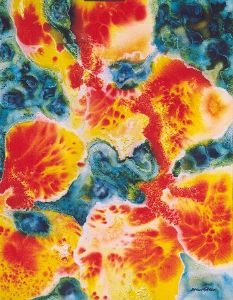

Nymphae Solaris
Acrylic,
US$
593

|
Nymphae Solaris
Add to your Shopping Cart
Remove from your Shopping Cart
Remove from your favorite works list
Add to your favorite works list
Send as an eCard!
Details
Acrylic
W: 700mm x H: 900mm x D: 50mm
W: 28" x H: 35" x D: 2"
This work is
unframed
Price
US$ 593
Scale
About "Nymphae Solaris"
FLORA FABULA
[0x1]A Collection of Blooms with Attitude[0x1]
[0x1]Blooms with attitude[0x1], indeed. It is a vibrant, positive attitude, though; one of celebration, vitality and growth [0x1] with just a touch of naughtiness here and there, just to spice things up a bit.
Eric M[0xC3B6]ller[0x1]s works are intense and powerful, but it is not an unbridled power [0x1] quite the contrary. The forcefulness if his expression is tempered by exquisite colour harmony and compositional integrity. Consequently his paintings are conversational, but not overwhelming [0x1] making them wonderful roommates! This is especially important if you[0x1]re not into all the academic chitchat about the how and why of these canvases, and simply want something to uplift a dreary corner or revitalise a lifeless room.
It is hardly a secret that flower-themes have been flooding our galleries for many decades [0x1] most of them trite, uninspired and safe little flowers at that! So what makes Flora Fabula worthy of our interest?
The artist probably answers this question best:
[0x1]Well, they[0x1]re not really flowers [0x1] they are perceptions of flowers. What I mean by this is that here we have images of everyday objects that have been filtered through a data bank of memories and emotional associations. For example, when we look at objects in the world around us, our first impulse is to recognise them [0x1] here[0x1]s a chair, there a car, and here a flower. This is vision [0x1] the ability to [0x1]see[0x1]. Perception goes beyond this. In our perception of the world we associate these objects with feelings and memories [0x1] consciously or not.[0x1]
M[0xC3B6]ller argues that this muddle of impulses actually causes us to perceive our world in a surprisingly abstract manner.
[0x1]Maybe this is why people seem so keen to confront abstract pieces. Their reaction to abstraction may be positive or negative, but a reaction is guaranteed! Abstraction reaches deep into our psyche [0x1] seeming to address something primordial, something that touches on the whole essence of meaning [0x1] the grasp of which has been plaguing mankind forever.
[0x1]So what I[0x1]m attempting to do here is to investigate my own perception of things I know well (in this case, flowers) [0x1] and to give a visual impression of these perceptions. It is a biased vision, I admit. The value of the experiment lies in the reaction of my audience; will they experience these images as flowers, emotions or meaning? Or maybe combinations of all three?
If you really want to push the envelope a bit here, you might even argue that this abstraction of reality is often the underlying cause of misunderstanding and conflict amongst people. But I[0x1]m not quite sure if I want to take the argument to that extreme at this stage of the investigation[0x1][0x1]
Pictures in the Flora Fabula Series are created in an intriguing manner. Firstly M[0xC3B6]ller finds his reference material. A flower, often from his garden. This flower is then drawn on the canvas [0x1] keeping the lines flowing and simple, and detail to the minimum. At this point the reference is put aside, although and under-painting in acrylic might still be based on colours suggested by the original. Now comes the interpretation phase. The object, here still fully recognisable, is interpreted as a visual stimulus. Association and feeling come into play. Slowly the forms begin to suggest what needs to happen next. This is a growth process [0x1] just like flowers grow and expand themselves. Flowers are, however, restricted by fundamental laws of nature [0x1] the artist[0x1]s mind and perception less so. The artist is lead to each new step by what has gone before, and knows not what the final piece will look like.
[0x1]At some point I know I need to stop. Maybe at the point when the canvas tells me that compositional integrity has been achieved, or maybe when I feel fulfilled. I don[0x1]t really know what the cues are.[0x1]
It has been stated by those privileged enough to see some of the works in progress, that certain of the images have a [0x1]naughtiness[0x1] about them. M[0xC3B6]ller responds quite simply: [0x1]Well, flowers are really leaves, mad with love, aren[0x1]t they? We give flowers to those we fancy [0x1] you figure it out[0x1][0x1]
Each painting carries a title that smacks of high school Latin. These are in fact not the plants[0x1] scientific names. [0x1]It is a bit of a tongue-in-cheek thing, really,[0x1] sniggers M[0xC3B6]ller. [0x1]I thought of creating my own kind of mock-Latin language to somehow give the whole thing apparent scientific credibility. The words are mostly based on English, and the idea is to further the whole perception thing [0x1] this time using the spoken word. It[0x1]s like listening to a foreign language and being able to deduce the gist of it by recognising individual words; just another abstract perception[0x1][0x1]
- From the Press Release for [0x1]Flora Fabula[0x1].
|
Remove Eric from your favorite artists list
Add Eric to your favorite artists list
View all 129 works by Eric Möller
About Eric

About the Artist -- (Article by: Griffin von Ritter for Art Busker Int.)
Eric Moller has been exhibiting his works since 1995. He has had eight solo exhibitions, taken part in numerous group exhibitions, was nominated twice as finalist in the PPC Sculpture Competition and was granted a SANAVA residency at the Cite Internationale des Arts in Paris, France. On this occasion he wrote a book about his experiences (86 Days in the City of Lights) which was subsequently published both locally and internationally. He is a teacher of Visual Arts and Design and lives a quiet life with his three dogs in the East of Pretoria.
Moller grew up in 'what was then a small sea-side town'. He hated school and was uncomfortable with family-life so he mostly headed off on his own. When he wasn't bounding after butterflies or accosting arachnids, he spent his time in the many secret spaces between the rocks by the sea, where he snorkeled and always found himself fascinated and utterly in awe of the unexpected and exotic life-forms that existed beneath the surface of the ocean.
'Had it not been that the Art Bug bit me early in my life, I would have been a Bug Scientist - no doubt!' he says.
'It is my early fascination with Natural History in its entirety that still drives my art today. In my art the expression is more condensed, though, in that it deals with a search for - or maybe an understanding of - the essence of the life force. It's about what makes us aware, feel, twitch and respond... about what makes us happy and sad; all in a very human, inexplicable way. On the one hand it is the love of life, the mystery, the magic, the incomprehensible mind-bending BIGNESS of it all... on the other it is the sadness I have felt all my life; the sense that there is an inescapable great emptiness following close behind, lapping at my heels.'
There is surely so much more that can be said about the man and his work. There are unfathomable depths that even he finds difficult and perplexing to explore, there is that scientific understanding of the stuff that holds us all together, there are so many more questions and there have most probably never really been answers.
I leave you with this: When you look at the works of Eric Moller, first see the colours, the tight composition, and the lines that twirl and contort in seductive dances and always lead you back to a new place - another place to start off from. Observe the pulsating shadows that entice you to search for more. See LIFE! See his technical mastery of the various mediums he uses. Now see 'the void', creeping up from behind. Somewhere in all of that celebration lurks something shadowy and cryptic... something that threatens to suck life, love, beauty and joy from all that we know. It is mostly announced (quite paradoxically) by the deepest tone of Moller's favourite colour - Prussian Blue.
As your mind boggles and wrestles with unexpected contortions, the artist does his magic - and you can always depend on it: the colours, lines, textures and all those other things that first you saw and that make these works so alluring grab a hold of you again and pull you back from the precipice. Suddenly there is joy. Life has meaning again.
These things, and probably other stuff we have not yet considered, make this artist's work poignantly important.
***
Eric Moller has works in private and corporate collections in South Africa, The United Kingdom, Canada, Australia, Germany, Portugal, The United States, The Netherlands and Singapore.
Price Range
US$ 158-3,951
Email
Exhibitions
Eight solo exhibitions and fourteen group shows.
Education
University of Pretoria
People who chose Eric's work also chose work by:
Find other:
|

 In the USA you can call us FREE on
In the USA you can call us FREE on






